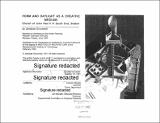| dc.contributor.author | Gruzewski, Jaroslaw. | en_US |
| dc.contributor.other | Massachusetts Institute of Technology. Department of Architecture. | en_US |
| dc.coverage.spatial | n-us-ma | en_US |
| dc.date.accessioned | 2011-11-01T19:39:06Z | |
| dc.date.available | 2011-11-01T19:39:06Z | |
| dc.date.copyright | 1991 | en_US |
| dc.date.issued | 1992 | en_US |
| dc.identifier.uri | http://hdl.handle.net/1721.1/66742 | en_US |
| dc.description | Thesis: M. Arch., Massachusetts Institute of Technology, Department of Architecture, February 1992 | en_US |
| dc.description | Includes bibliographical references (p. 134-135). | en_US |
| dc.description.abstract | This thesis is an architectural design project of a Catholic Church dedicated to Pope John Paul II. The main intention of this Thesis is to explore and clearly present daylighting methods and techniques and how important role they can play as the form-givers for an architectural design. This Thesis will also provide an answer for making daylight design process more inspiring and free from often misleading, graphic "artificial" methods. In my opinion, daylight design requires professional knowledge and sensitivity much beyond simple technical rules or restrictive tables. I believe, that daylight is a visual phenomenon "in motion", and cannot be fully captured and framed under scientifically provided guidelines. This Thesis will also research a vital architectural design issue, that "daylighting is not something one adds to building design -- it is implicit to every design decision." Through the method of this Church's architectural design process, I will explore the potentials and limitations of daylight and its qualities. I will also present how both light and architectural form can be used to strengthen the spatial experience. Finally, this Thesis will answer questions regarding the provision of light for the performance of visually related activities in the Church of John Paul II, including the Baptistery, Reading Room, and Auditorium. For most of us, Vision is the most powerful of our five senses and the main receptor of information, conditioning our memory and imagination. Sight (light, form and color) is the primary medium through which our surrounding is seen. Therefore, architecture receives its most powerful and true expression through the mediums, of sight as well as "form and daylight". | en_US |
| dc.description.statementofresponsibility | by Jaroslaw Gruzewski. | en_US |
| dc.format.extent | 137 p. | en_US |
| dc.publisher | Massachusetts Institute of Technology | en_US |
| dc.rights | MIT theses may be protected by copyright. Please reuse MIT thesis content according to the MIT Libraries Permissions Policy, which is available through the URL provided. | en_US |
| dc.rights.uri | http://dspace.mit.edu/handle/1721.1/7582 | en_US |
| dc.subject | Architecture. | en_US |
| dc.title | Form and daylight as a creative medium : Church of John Paul II in South End, Boston | en_US |
| dc.type | Thesis | en_US |
| dc.description.degree | M. Arch. | en_US |
| dc.contributor.department | Massachusetts Institute of Technology. Department of Architecture | en_US |
| dc.identifier.oclc | 26376592 | en_US |
| dc.description.collection | M. Arch. Massachusetts Institute of Technology, Department of Architecture | en_US |
| dspace.imported | 2023-10-06T21:30:28Z | en_US |
